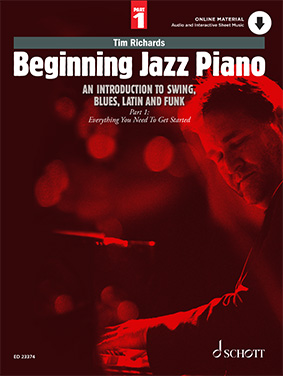Originally posted by Melanie Spanswick - The Classical Piano and Music Education Blog, June 20, 2021.
Original post:www.melaniespanswick.com
BEGINNING JAZZ PIANO
Part 1: Everything You Need to Get Started
Schott Music ED 23374
Since my two-volume method 'Exploring Jazz Piano' was published by Schott Music in 2005 I’ve been asked countless times whether it would be possible to produce something with a gentler learning curve, catering for the complete newcomer to jazz.
At last, this is that book! If you have a basic piano technique this will help you make the transition from reading sheet music to improvising creatively, and above all using your ears. It’s also a book you can use with a friend or teacher, who can accompany you by playing the written bass lines provided, thereby making sure you keep good time and stay ‘in the groove’.
My interest in jazz and improvisation began in my early teenage years. I’d had lessons since the age of 8, and my piano teacher Carola Grindea had always encouraged creativity at the keyboard, despite not being a lover of jazz. Around the age of 14 my fascination with the music on my father’s collection of 78rpm records (Duke Ellington, Louis Armstrong, Django Reinhardt, amongst others) took over from the playing of Scarlatti sonatas, so Carola and I parted company.
I remember this period vividly as one of confusion and experimentation. Knowing nothing about jazz harmony, form or repertoire, and with no one around to help, I often felt completely in the dark. There were very few books around at the time that explained the mechanics of jazz and improvisation, and I often resorting to playing along with records or the radio.
I believe the easiest way into jazz is via the blues, largely on account of its simple, easy to grasp form (12 bars) and harmonic structure (3 chords). My first book, 'Improvising Blues Piano' (published by Schott in 1997), was a compendium of different blues styles, many of which share several features with jazz (eg: swing quavers, walking bass lines, improvised solos). A little later a couple of pieces from the book were included in the ABRSM Jazz Piano syllabus, and for the next 20 years, in parallel with my activities as a performer, I worked as an ABRSM jazz examiner.
'Beginning Jazz Piano' draws on my long experience of teaching jazz, both privately and in classes, and I’ve tried to make it as easy as possible to get involved. In the first chapter you are coaxed into improvising over ONE chord only; the ‘Listening’ section gives a list of tracks where you can hear this on recordings. Such a basic harmonic backdrop allows you to focus on other crucial elements such as melody, rhythm, phrasing, coordination and fingering. Every piece has a backing track to play along with if a friend or teacher is not around to play the given bass line.
Chapter 2 ups your game to improvising over TWO alternating chords. Pieces refer to iconic tracks by Bill Evans and Keith Jarrett, and other famous examples are given in the ‘Listening’ section. It is my belief that this type of activity should be included in piano lessons from an early age (jazz and classical), and that it transforms the learning of scales from a dull chore into a fun and creative experience. It’s definitely one of the most important things I share with piano teachers attending the ABRSM Jazz Piano Syllabus course (currently hosted by Benslow Music).
Chapter 3 adds a third chord and it’s at this point that you can start playing a ‘three-chord trick’ ie: a twelve-bar blues. Jazz harmony can be an overwhelming topic for the newcomer and I think that breaking it down into these simple steps gives everyone a way in.
There are two other features that are new to this book: the first is the inclusion of three SING & PLAY tracks which develop your familiarity with pentatonic (5-note) scales by alternating singing and playing four-note groups, in various hand positions. These are designed to help you hear phrases in your head before playing, an essential requirement for the successful improviser.
The other innovative feature of 'Beginning Jazz Piano' is the REPLAY files that are provided for each piece. Developed and hosted by MUSICGURUS.com, these scrolling music files are accessed online and allow you to slow down or loop sections of the pieces for practice purposes. I am sure this interactive component of the book will be popular, bearing in mind the increasing number of people who have turned to online learning during recent Lockdowns.
You can find out more, and purchase the book, here.
Buy Beginning Jazz Piano Part 1 (GB Pounds)
Buy Beginning Jazz Piano Part 1 (Euros)
